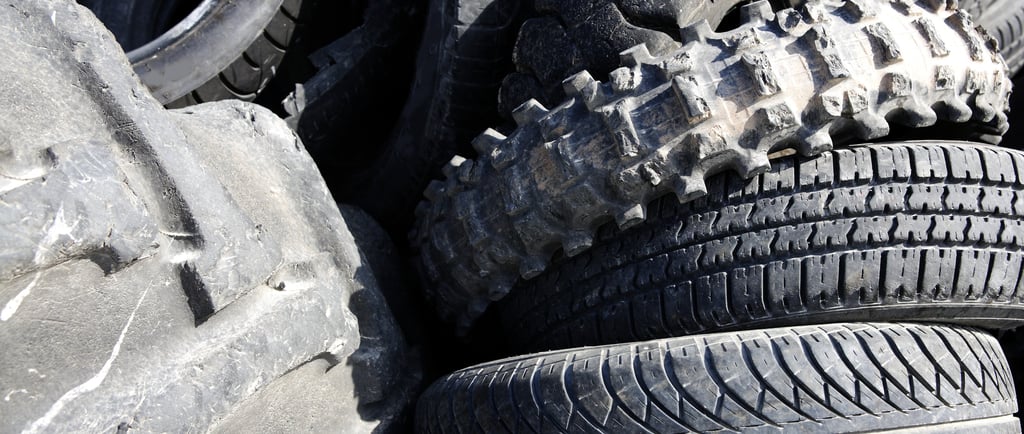The Global Footprint: How Tire Pyrolysis is Solving a Worldwide Problem, One Tire at a Time
THE STORIES
TYROIL
6/16/20254 min read


Close your eyes for a moment and picture a mountain. Not a majestic, snow-capped peak, but a dark, sprawling heap of discarded tires, stretching as far as the eye can see. This isn't a scene from a dystopian movie; it's a stark reality in many parts of the world, a testament to the sheer volume of waste tires generated annually. From bustling megacities to remote villages, the waste tire crisis casts a long shadow, impacting ecosystems and communities alike. But amidst this global challenge, a powerful solution is emerging, one that is adaptable, economically empowering, and is slowly but surely transforming these rubber mountains into valuable resources: tire pyrolysis.
A Universal Challenge, A Universal Solution
The problem of waste tires knows no borders. Whether it's the millions of vehicles on the roads of North America, the rapidly expanding automotive markets in Asia, or the growing transportation needs in Africa, every tire eventually reaches its end-of-life. Globally, an estimated 1.5 billion tires are discarded each year [1]. Managing this colossal volume of waste is a universal challenge, but the approaches to tackle it vary widely:
Developed Nations: Often have established recycling programs, but even with these, a substantial amount of end-of-life tires (ELTs) still requires alternative solutions. Some rely on energy recovery through incineration, which can have air quality concerns if not properly managed [2].
Developing Nations: May face greater challenges in waste management infrastructure, leading to widespread illegal dumping or uncontrolled burning of tires, exacerbating environmental and health problems [3].
This global disparity underscores the need for a versatile and effective solution that can be implemented worldwide, regardless of economic development or existing infrastructure. Tire pyrolysis fits this description perfectly. Its core principle – thermal decomposition in the absence of oxygen – makes it adaptable to various contexts and scales, from smaller, localized operations to large industrial plants [4]. It's a technology that can be tailored to the specific needs of a region, offering a universal answer to a pressing global problem
Stories from Around the World: A Quiet Revolution
While specific names and locations might not be widely known, the quiet revolution of tire pyrolysis is unfolding across continents. In countries grappling with limited landfill space, pyrolysis offers a lifeline, diverting millions of tons of tires from overflowing dumps. In regions seeking to reduce their reliance on imported fossil fuels, TPO provides a domestic, waste-derived energy source, strengthening local energy security. And in communities striving for cleaner air, pyrolysis offers a stark contrast to the polluting practices of open burning.
Imagine a community in Southeast Asia, once plagued by illegal tire dumps that bred mosquitoes and posed fire risks. With the introduction of a small-scale pyrolysis plant, those dumps are slowly disappearing, replaced by a facility that converts the waste into fuel for local industries and recovered carbon black for new products. Or consider a European nation, committed to circular economy principles, where large-scale pyrolysis operations are integrated into their industrial ecosystem, providing sustainable raw materials and energy.
These are not isolated incidents but part of a growing global trend. Research from Scopus-indexed journals indicates a significant increase in studies and projects related to waste tire pyrolysis worldwide, reflecting a collective commitment to finding sustainable solutions [5].
Economic Empowerment: Turning Waste into Wealth
The global impact of tire pyrolysis extends beyond environmental benefits; it also fosters economic empowerment. By transforming waste tires into valuable products like Tire Pyrolysis Oil (TPO), recovered carbon black (rCB), and steel wire, pyrolysis creates new revenue streams and stimulates local economies [6].
Job Creation: From the collection and processing of waste tires to the operation and maintenance of pyrolysis plants, new jobs are created, providing livelihoods for communities.
Reduced Costs: For industries, using TPO can mean a more stable and potentially lower-cost fuel source, reducing operational expenses and increasing competitiveness.
Resource Independence: For nations, local TPO production reduces reliance on volatile global energy markets, contributing to greater economic stability and resilience.
This shift from viewing waste as a burden to recognizing it as a resource is a powerful driver of economic growth, particularly in regions where traditional resource extraction is limited.
Connecting the Dots for a Cleaner Planet: One Tire at a Time
The global footprint of tire pyrolysis is a testament to the power of collective action and innovative thinking. Each tire processed, each barrel of TPO produced, each ton of carbon black recovered, contributes to a larger, interconnected effort to build a cleaner, more sustainable planet. It's a ripple effect, where local solutions contribute to a global impact.
By embracing tire pyrolysis, we are not just managing waste; we are actively participating in a global movement towards a circular economy. We are transforming a symbol of environmental degradation into a beacon of hope, demonstrating that even the most challenging waste problems can be solved with ingenuity and a commitment to sustainability. The journey is ongoing, but with each tire given a second life, we move closer to a world where waste is a resource, and our planet thrives.
References
[1] Hashamfirooz, M., et al. (2025). A systematic review of the environmental and health effects of waste tire pyrolysis. Environmental Science and Pollution Research, 32(1), 1-15. [https://pmc.ncbi.nlm.nih.gov/articles/PMC11783015/]
[2] Maga, D., et al. (2023). A comparative life cycle assessment of tyre recycling using pyrolysis against current dominant alternative end-of-life options. Resources, Conservation and Recycling, 198, 107170. [https://www.sciencedirect.com/science/article/pii/S0921344923003890]
[3] Afash, H., et al. (2023). Recycling of Tire Waste Using Pyrolysis: An Environmental and Economic Review. Sustainability, 15(19), 14178. [https://www.mdpi.com/2071-1050/15/19/14178]
[4] Zhang, M., et al. (2024). A review on waste tires pyrolysis for energy and material recovery from the optimization perspective. Energy Conversion and Management, 302, 118086. [https://www.sciencedirect.com/science/article/abs/pii/S1364032124002545]
[5] Zaki, Z. S. N. R. M., et al. (2025). Global trends of waste tire pyrolysis research. Journal of Cleaner Production, 440, 140800. [https://www.sciencedirect.com/science/article/pii/S2772783125000135]
[6] Goksal, F. P., & Yildiz, G. (2022). An economic analysis of scrap tire pyrolysis, potential and challenges. Heliyon, 8(11), e11796. [https://www.cell.com/heliyon/fulltext/S2405-8440(22)02957-7]
